Quality 4.0: Powerful Innovation Enabler
This infographic details how Quality 4.0 leverages the critical technology changes of Industry 4.0, which enable quality to transform performance,...
Installing a cloud-based Enterprise Quality Management System (EQMS) does not equal Quality 4.0. EQMS accomplishes a portion of the scope of a Quality 4.0 program, an important part, but it is not the sum total of a Quality 4.0 journey.
At LNS Research, we defined Quality 4.0 in 2017 to be the application of digital tools and systems to transform the work of Quality and achieve step change improvements in the customer value chain. So, in summary, Quality 4.0 is targeted at creating value for the customer.
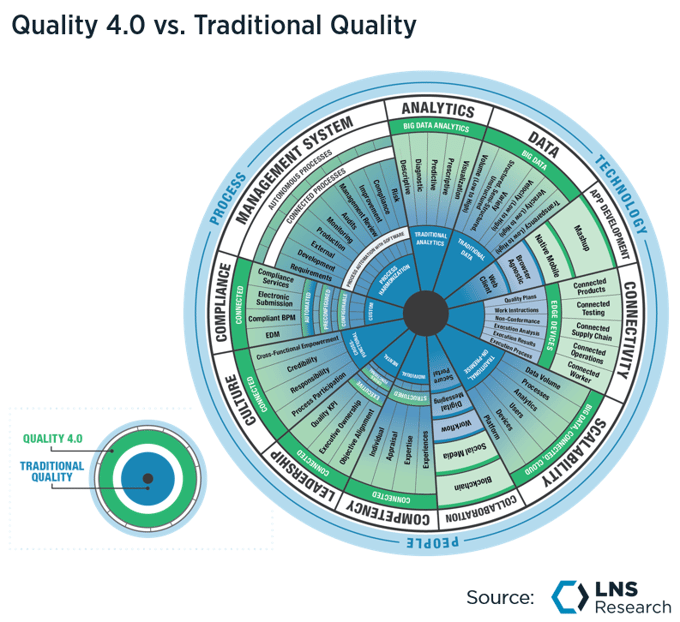
An EQMS is a vital part of that, but the role of an EQMS is targeted at reducing the burden on personnel to perform the normal, regular processes associated with the Quality function. Things like;
Corrective and Preventive Action
Customer Complaints Management
Product Deviation Management
Qualification
Event Management
Audits
Management Review
Document Control
All of those processes need to be done and in old days, those things required some manual effort and time to move forward. This sometimes resulted in the ball being dropped and issues that should be followed up on and closed in a closed loop manner were not. An EQMS gives Quality leaders a better chance of capturing issues and seeing them through to completion through a systematic approach with Robotic Process Automation connecting all of the processes needed to close the loop together. It can also provide visibility and analytics into how these processes are performing and improves the ability to integrate these processes across the value chain from suppliers to customers and critical functions in between, as well as automatically collect data from these processes - but that alone isn't transformation.
In other words, an EQMS makes the work of Quality Management less difficult and less bureaucratic. An EQMS, even a cloud-based EQMS with some analytics and AI is still a content-driven system where events are managed and data is secondary. Quality 4.0 is an approach where data is used to manage content.
Quality 4.0 is a transformative approach to Quality that affects the entire value chain from innovation to sustainment; from the supply base to customers; and from order to cash (Figure 1). A robust Quality 4.0 transformation spans the three aspects of an effective transformation; People, Process, and Technology and is intended to add value for the customer. Read more about Quality 4.0 and strategy recommendations in our Quality 4.0 Impact and Strategy Handbook.
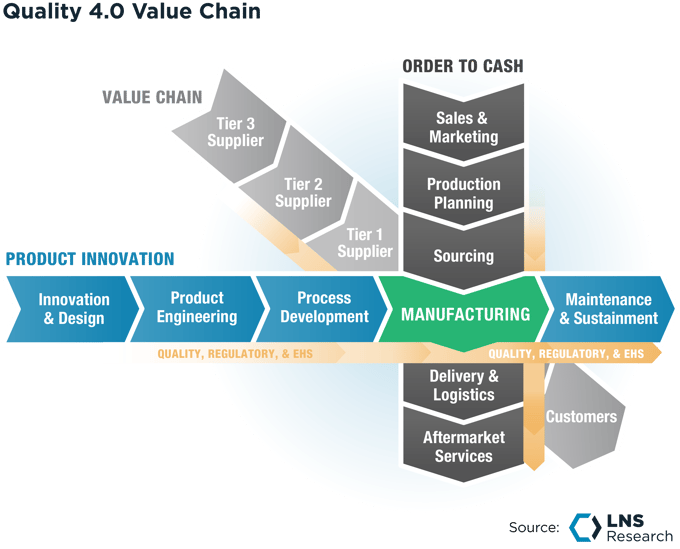
The graphic below in Figure 2 represents the additional considerations needed to achieve the vision of Quality 4.0. EQMS is the digital “system of record” in which the work of Quality Management happens, but additional context is needed to achieve the vision to value creation for the customer. Those additional contexts are customer-facing business processes, Machine Learning/Artificial Intelligence and Advanced Analytics and the data to perform those Advanced Analytics.
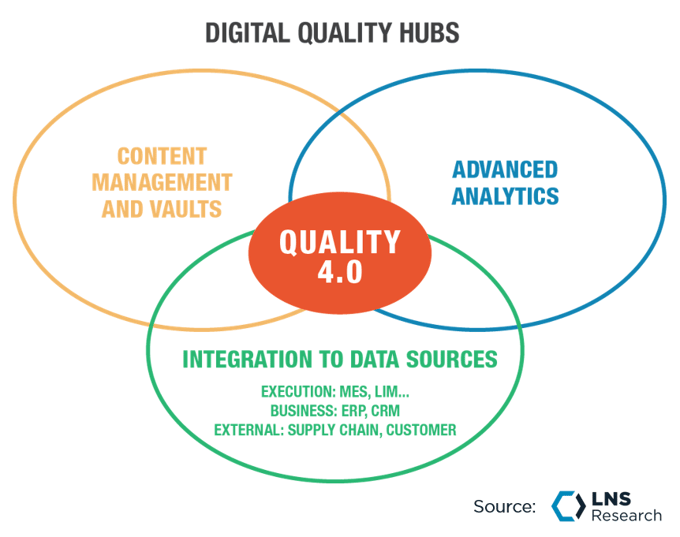 The point of these additional layers is to bring Advanced Analytics to bear on customer-facing business processes and achieve insights that deliver higher value to the customer. Below, in Figure 3, we show the relationship between Quality Management and Quality Execution, or Quality Assurance and Quality Control in the Quality parlance. We can see by these typical use cases, that there is a strong role for Artificial Intelligence/Machine Learning and Advanced Prognostic Analytics in delivering valuable insights that clearly go beyond the documentation of a complaint or a corrective action. But Quality 4.0 goes further than that.
The point of these additional layers is to bring Advanced Analytics to bear on customer-facing business processes and achieve insights that deliver higher value to the customer. Below, in Figure 3, we show the relationship between Quality Management and Quality Execution, or Quality Assurance and Quality Control in the Quality parlance. We can see by these typical use cases, that there is a strong role for Artificial Intelligence/Machine Learning and Advanced Prognostic Analytics in delivering valuable insights that clearly go beyond the documentation of a complaint or a corrective action. But Quality 4.0 goes further than that.
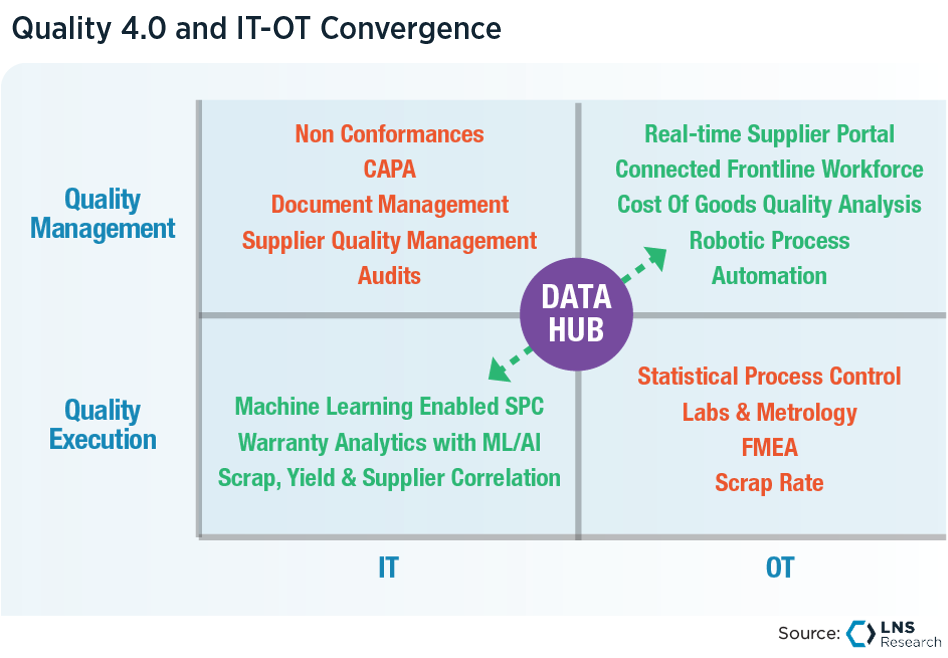
For Quality 4.0 transformations to truly achieve the vision, visibility of the entire contextual dataset from suppliers, customers, and manufacturing operations, research and development is essential. It is difficult to achieve this consolidation in a single Data Lake and is more likely to exist in multiple Data Lakes, each dedicated to a particular portion of the value chain. This challenge for alignment and contextualization of data brings the Data Hub concept to the forefront, where the Data Hub pulls specific contextual data from relevant Data Lakes across the enterprise, and applies Advanced Analytics and ML/AI to deliver actionable insights for Robotic Process Automation (RPA) enabled workflow processes to kickoff and perform some basic level of decision making for people to then finish the rest of the process. Figure 4 below depicts this entire architecture. Read more LNS Research recommendations around a Data Hub architecture in our Digital Quality Hub Driving New Organizational Models research spotlight series.
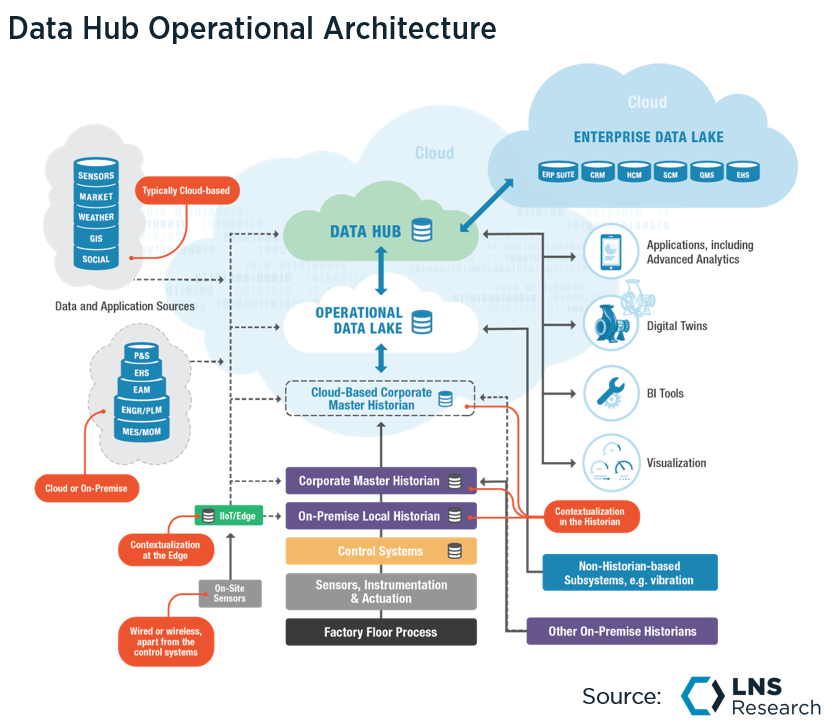
Manufacturers considering implementing an Enterprise Quality Management System should think about the long view of where they need Quality to go in their companies. Build in requirements for that future capability, making the selection “Future-Proof”, modular, and flexible to build additional capabilities with greater and greater access to Data Lakes across the enterprise and the intelligence that is created by that additional context as the use cases mature.
For EQMS providers, integrating AI and Advanced Analytics into your solutions is potentially a win-lose scenario. It’s a win for those customers who don’t already have some Advanced Analytics and/or AI practices in-house. However, the potential problems with this approach include that not all enterprise data flows through an EQMS system and if an enterprise already has an AI or Analytics practice in force, can you connect to it? The order of the day for future EQMS is modularity and flexibility.
Automating data connections and including more data across the enterprise to produce a seamless, holistic, systematic, data-driven approach to Quality management allows Quality personnel to elevate their gaze from the mundane bureaucratic tasks and begin to operate on a higher level, that of trusted business partners.
All entries in this Industrial Transformation blog represent the opinions of the authors based on their industry experience and their view of the information collected using the methods described in our Research Integrity. All product and company names are trademarks™ or registered® trademarks of their respective holders. Use of them does not imply any affiliation with or endorsement by them.
As a member-level partner of LNS Research, you will receive our expert and proven Advisory Services. These exclusive benefits give your team:
Let us help you with key decisions based on our solid research methodology and vast industrial experience.
BOOK A STRATEGY CALLSiemens Acquires Camstar: Better Realizing Innovation for 3 Vertical Industries
The Definitive Guide to Manufacturing Acronyms
Five Ways Industrial AI is Shaking Up Manufacturing (and Who’s Doing It)
Top 6 Challenges in Electronics Manufacturing
What Is Industrial DataOps & Why Does Every Manufacturer Need It?
This infographic details how Quality 4.0 leverages the critical technology changes of Industry 4.0, which enable quality to transform performance,...
Quality 4.0 is the digitalization of quality through the application of traditional and Industry 4.0 technologies to improve and better monitor...
Transforming your quality management approach with Embedded Quality, leveraging Quality 4.0 technologies across the value chain.
The Industrial Transformation and Operational Excellence Blog is an informal environment for our analysts to share thoughts and insights on a range of technology and business topics.